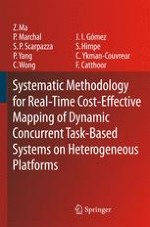The main intention of this book is to give an impression of the state of the art in energy-aware task-scheduling-related issues for very dynamic emb- ded real-time processing applications. The material is based on research at IMEC in this area in the period 1999–2006, with a very extensive state-- the-art overview. It can be viewed as a follow-up of the earlier “Modeling, veri?cation and exploration of task-level concurrency in real-time embedded systems” book [234] that was published in 1999 based on the task-level m- eling work at IMEC. In order to deal with the stringent timing requirements, the cost-sensitivity and the dynamic characteristics of our target domain, we have again adopted a target architecture style (i. e. , heterogeneous mul- processor) and a systematic methodology to make the exploration and op- mization of such systems feasible. But this time our focus is mainly on p- viding practical work ?ow out of the (abstract) general ?ow from previous book and also the relevant scheduling techniques for each step of this ?ow. Our approach is very heavily application-driven which is illustrated by several realistic demonstrators. Moreover, the book addresses only the steps above the traditional real-time operating systems (RTOS), which are mainly focused on correct solutions for dispatching tasks. Our methodology is nearly fully independent of the implementations in the RTOS so it is va- able for the realization on those existing embedded systems where legacy applications and underlying RTOS have been developed.
